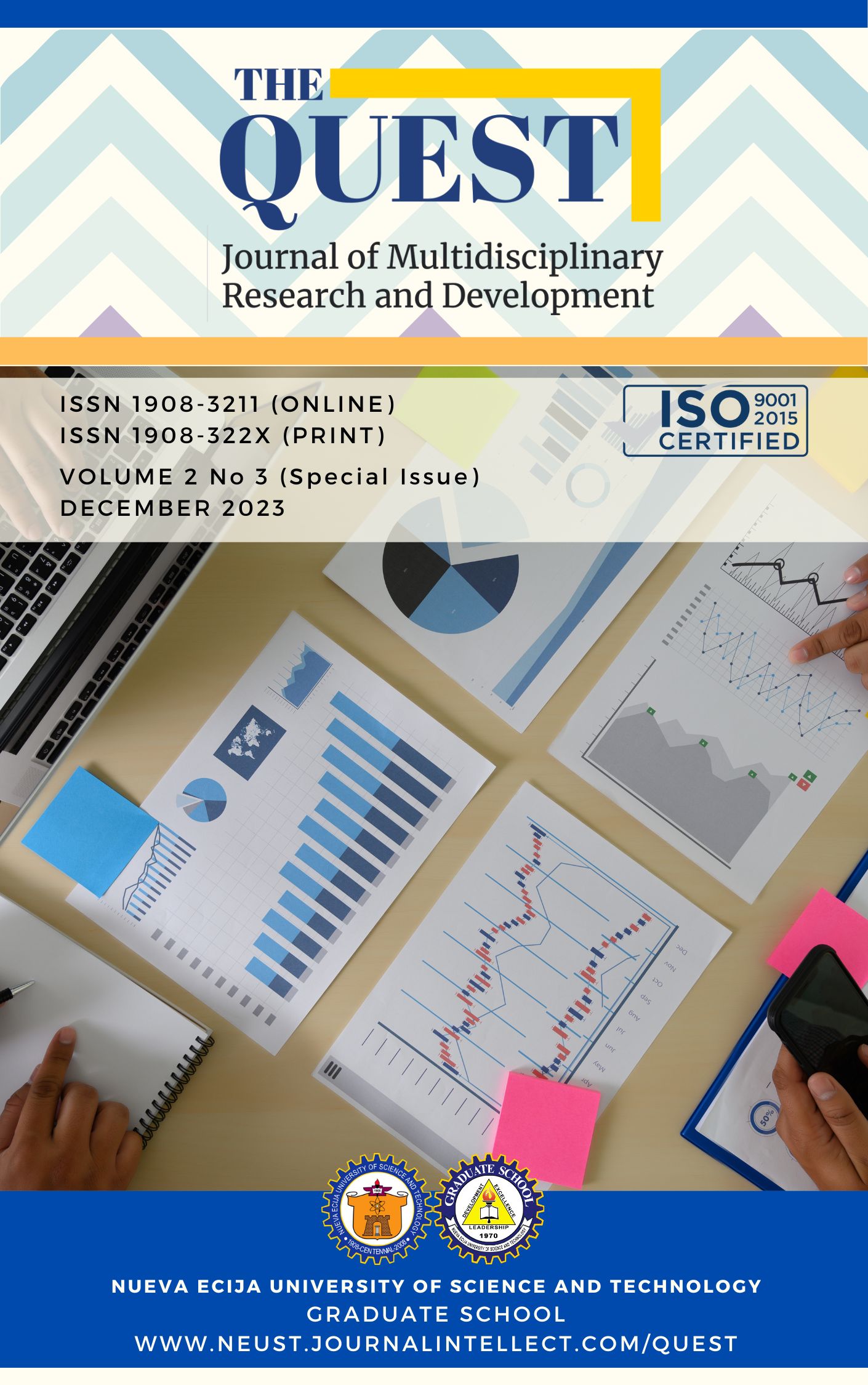The Role of City Employees Credit Cooperative and Allied Services (CECCAS) on Improving the Household Income of Employees of the City Government of Cabanatuan

Published 12/30/2023
Keywords
- Credit Cooperatives
How to Cite
Copyright (c) 2023 The QUEST: Journal of Multidisciplinary Research and Development

This work is licensed under a Creative Commons Attribution-NonCommercial 4.0 International License.
Abstract
Credit cooperatives were essentially created to meet the basic human desire for borrowing and saving money without taking on too much risk or giving the money lender too much authority. Members of credit cooperatives attain socio-economic benefits through its products and services and understanding its effects is vital in improving its management. Most often, cooperatives do not visualize the impact of its services to its members due to lack of proper documentation and research focusing on them. This study examines how credit cooperatives specifically the City Employees Credit Cooperative and Allied Services (CECCAS) affects the household income of its members in terms of savings deposit, building of assets, and availment of loans. Using descriptive-survey approach, the study gathered information through survey questionnaires and interview sessions from the members of CECCAS. Results of the study showed that in terms of improving household income, savings/contributions and loan products significantly benefit the members of the cooperative. Availment of loan products help the members to finance their needs and buy assets but members have yet to engage in income-generating activities. Savings on the other hand, pave the way for members to have emergency funds, buying of assets, medical and study funds. This study examined the benefits of a credit cooperative in terms of improving household income of its members, variables such as membership growth, management styles, women’s participation, and other socio-economic aspect may be applied to gain more understanding in this sector.
References
- Abocejo, Belciña, S. A., Diones, L. L., Dotillos, L. T., F. T., Pañares, Z. A., (2012). Microfinance Lending Program of Cooperatives in Cebu, Philippines: Realities, Benefits, and Women’s Participation: CNU Journal of Higher Education
- Adler, P. S. & Kwon, S. (2002). Social capital: Prospects for a new concept. Academy of Management Review 27 (1) : 17-40.
- Agutaya, C. A. (2016). Socio-Economic Development of the Members of Two Multi-Purpose Cooperatives in Calapan City, Oriental Mindoro, Philippines: Asia Pacific Journal of Multidisciplinary Research
- Birchall, J. (2004). Cooperatives and the Millennium Development Goals. Strategy (pp. 1–101).
- Castillo, E. T. & Castillo M. D. (2017). Cooperatives in the Socio-Economic Development of the Philippines. In 10th Asia Pacific Cooperative Ministers’ [Retrieved March 9, 2023 thru https://cda.gov.ph/updates/cooperatives-in-the-socio-economic-development-of-the-philippines/]
- Castro, N. F. & Castro, C. C. (2020). Examining the Effectiveness of Selected Credit Cooperatives in the Province of Pangasinan: Perspective from the Management and Members. Asian Journal of Multidisciplinary Studies Vol. 3, No. 2, ISSN 2651-6691
- Dogarawa, A. B. (2012). The Role of Cooperative Societies in Economic Development. SSRN Electronic Journal. https://doi.org/10.2139/ssrn.1622149
- Hermanson, J. A., Hoist, A., Jones, B. C. & Lucas, L. M. (2021). What Difference Do Cooperatives Make? U.S. OCDC International Cooperative Research Group, Kenya Country Study
- Langat, J. (2016). Influence of Savings and Credit Cooperative Societies’ Products on Members Livelihoods: A Case of Imarisha SACCO. Master’s Thesis, Masters of Arts in Project Planning and Management, University of Nairobi.
- Llanto, G. M. (1994). The Financial Structure and Performance of Philippine Credit Cooperatives. Discussion Paper Series No. 94-04. Philippine Institute for Development Studies.
- Levin, M. (2002). The promotion of Cooperatives, ILO Cooperative Branch, at www.ica.coop/europe/ra2002/speech
- Nnyanja, W. (2017). The Role of Saving and Credit Cooperatives in Improving Household Income: The Case for Teachers in Mukono District: CourseHero
- Oluyombo, O. O. (2010), Assessing the Impact of Savings and Credit Cooperative Among Monthly Earners: Research Gate
- Oluyombo, O. O. (2013), Impact of Cooperative Finance on Household Income Generation. DLSU Business & Economics Review 23.1 (2013), pp. 53-67.
- Relampagos J., Lamberte, M., & Graham, D. (1990). A Study of The Operations and Performance of Selected Credit Cooperatives in the Philippines. Working Paper Series No. 90-23. Philippine Institute for Development Studies.
- Republic Act No. 9520, Philippine Cooperative Code, Article IV. (2008). [Retrieved March 9, 2023 thru https://www.officialgazette.gov.ph/2009/02/17/republic-act-no-9520/]
- Republic Act No. 11535. (2020) An Act Making the Position of a Cooperatives Development Officer Mandatory in The Municipal, City and Provincial Levels, Amending for The Purpose Republic Act No. 7160, Otherwise Known as the “Local Government Code Of 1991”, As Amended. (2020). [Retrieved March 9, 2023 thru https://www.officialgazette.gov.ph/downloads/2021/03mar/20210409-RA-11535RRD.pdf]
- The 1987 Constitution of the Republic of the Philippines, Article II, Section 6. (1987). [Retrieved March 9, 2023 thru https://www.officialgazette.gov.ph/constitutions/1987-constitution/]
